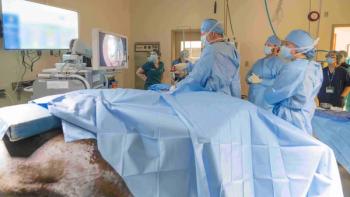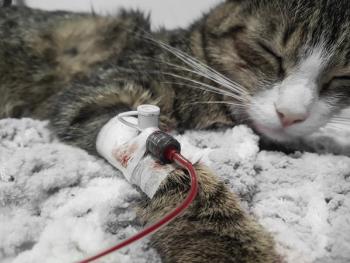
- Firstline May/June 2020
- Volume 16
- Issue 3
Leaky anesthesia machine? How to check the scavenging system
Using an anesthesia machine that is not working properly poses an unnecessary risk to both patients and personnel. Heres how to evaluate for leaks in your machines scavenging system.
Excess gas exiting the pop-off valve of an anesthesia machine's breathing system is collected and diverted into the scavenging system. The scavenging system can be active or passive.
An active scavenging system consists of a piped vacuum and duct system that carries the waste anesthetic gas (WAG) away from the anesthesia machine. The interface of an active scavenging system can be open or closed. An open interface does not contain valves and is open to the atmosphere, allowing both positive and negative pressure relief to occur spontaneously. This is considered the optimal design for patient safety.
This article describes how to check the scavenging system of an anesthesia machine for leaks.
What about the rest of the machine?
Detailed instruction on how to check for leaks in the breathing and pressure systems of a veterinary anesthesia machine can be found here and here.
Checking an active system
A closed interface consists of a knob that allows for adjustment of suction/vacuum, a collection bag, a positive-pressure relief valve and a negative-pressure relief valve (Figure 1). The collection bag on the scavenging system interface acts as a holding area for WAG coming from the anesthesia machine until it can be drawn properly into the scavenging system. The collection bag should be examined regularly to ensure there are no holes, especially around the neck of the bag. A collection bag that has a leak will act as a source of WAG contamination into the workplace.
Closed interface of an active scavenging system. (Photo courtesy of Darci Palmer, BS, LVT, VTS [Anesthesia & Analgesia])
If suction/vacuum on the scavenging interface is set too low, then the WAG leaving the anesthesia machine may exceed the capacity of the scavenging collection bag. If the scavenging collection bag becomes too distended, the positive-pressure relief valve will open and allow WAG to escape into the room.
To ensure this valve is working properly, attach a circle system to the anesthesia machine and occlude the patient end. With the pop-off valve open, activate the oxygen flush valve. The positive-pressure relief valve on the scavenging interface is working properly if the machine's manometer indicates a pressure of less than 10 cm H2O when the collection bag is fully distended.1
If suction/vacuum on the scavenging interface is set too high, then there is potential for the active scavenging system to pull fresh gas away from the patient. The negative-pressure relief valve acts as a safety feature that will open to allow ambient air to enter the scavenging system if negative pressure is detected.
To make sure the negative-pressure relief valve is working properly, attach a breathing circuit and reservoir bag. Keep the pop-off valve open, occlude the patient end of the circuit and turn on the oxygen flowmeter to a minimum setting. Apply suction to the scavenging system using a pipeline vacuum and observe the scavenging collection bag collapse. The manometer on the anesthesia machine should indicate a negative pressure of no more than 1 to 2 cm H2O if the negative pressure relief valve is working properly.1
Checking a passive system
Passive scavenging systems that use an adsorption canister contain activated charcoal that effectively scavenges the halogenated inhalants. However, they do not properly scavenge nitrous oxide. These canisters must be changed on a regular basis to prevent WAG contamination.
Several brands of adsorption devices are available. F/AIR (A.M. Bickford) and Breath Fresh (JorVet) must be changed when a 50-g weight gain has occurred, whereas Enviro-Pure (SurgiVet) must be changed when a 100- to 120-g weight gain has occurred.
Some references suggest changing the adsorption canister after 12 to 15 hours of use. Exhausted canisters can be a significant source of inhalant exposure to personnel. Excessive oxygen flow rates (>3 L/minute) may decrease the effectiveness of the adsorption canisters. The presence of WAG at an adsorption canister can be detected using the refrigerant leak detector described here.
Darci Palmer became a veterinary technician specialist in anesthesia and analgesia in 2006. She holds the executive secretary position for the Academy of Veterinary Technicians in Anesthesia and Analgesia. Darci is an instructor for the Veterinary Support Personnel Network (VSPN) and an administrator for the Facebook group Veterinary Anesthesia Nerds.
Articles in this issue
over 5 years ago
Thoughts from a small animal surgical nurseover 5 years ago
Is managing feline hyperthyroidism a team sport?over 5 years ago
How to ace a veterinary technician job interviewalmost 6 years ago
New managers: 6 tips for a great startabout 6 years ago
Leaky anesthesia machine? How to check the pressure systemsabout 6 years ago
Leaky anesthesia machine? How to check the breathing systemabout 6 years ago
When felines attack: 5 reasons cats go berserkabout 6 years ago
When a new dog is too much for an older clientabout 6 years ago
Cheat sheet: Service dogs, ESAs and petsNewsletter
From exam room tips to practice management insights, get trusted veterinary news delivered straight to your inbox—subscribe to dvm360.




